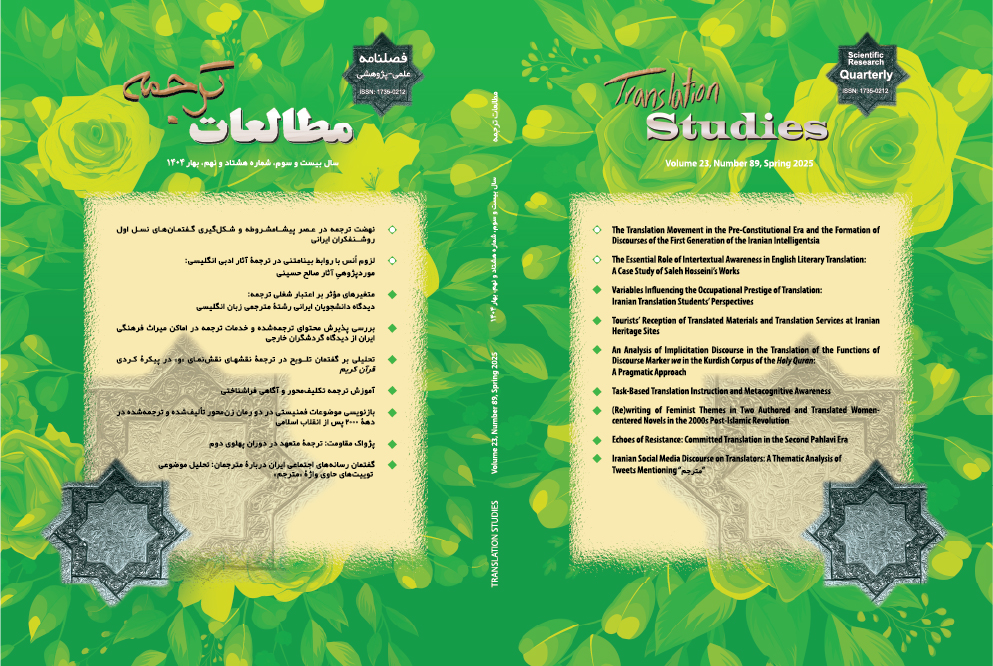Iranian Social Media Discourse on Translators
A Thematic Analysis of Tweets Mentioning "مترجم"
Abstract
In the age of social media, conducting reception studies has become significantly easier, as individuals readily express their opinions online. Thus, researchers can collect and analyze existing data without the need for direct interaction. Twitter (now known as X) serves as a rich source of user-generated content, while protecting users' privacy remains essential. This paper aimed to investigate the views of Iranian X users regarding translators and the themes of Persian tweets in which the word 'مترجم' [Translator] was used. This study provides a better understanding of readers’ perceptions and feedback regarding translators and their performance. To this end, a thematic analysis was conducted on a corpus of tweets between June 2023 and May 2024, using Chesterman's (2007) 'Reaction, Response, and Repercussions' Model as a framework. The findings revealed seven observable themes in Iranian tweets. The most prominent theme was ‘introduction of books and translators’, while the least common was ‘search for translators and job offers’. These findings suggest that, while X may not be an ideal platform for recruiting translators, it serves as a valuable space for introducing noteworthy books and translators to others, as well as for commenting on their performance, whether positively or negatively.
References
Ahmed, W., Bath, P. A., & Demartini, G. (2017). Chapter 4: Using Twitter as a Data Source: An Overview of Ethical, Legal, and Methodological Challenges. In K. Woodfield (Ed.), Advances in Research Ethics and Integrity (Vol. 2, pp. 79–107). Emerald Publishing Limited. https://doi.org/10.1108/S2398-601820180000002004
Attaran, A., & Farahzad, F. (2024). “I suggest you read my translation of this thread”: Twitter and paratextual interventions of the journalator. Iranian Journal of Translation Studies, 22(85). u
Bolouri, M., & Jalali, J. (2023). Translated fiction in Iran: Readers’ reception and expectations. Journal of Language Horizons, 7(3), 209–234. https://doi.org/10.22051/lghor.2023.40559.1695
Braun, V., & Clarke, V. (2006). Using thematic analysis in psychology. Qualitative Research in Psychology, 3(2), 77–101. https://doi.org/10.1191/1478088706qp063oa
Chesterman, A. (2007). Bridge concepts in translation sociology. In A. Fukari & M. Wolf (Eds.), Constructing a sociology of translation (pp. 171–183). John Benjamins.
Desjardins, R. (2017). Translation and Social Media: In Theory. In R. Desjardins, Translation and Social Media (pp. 35–66). Palgrave Macmillan UK. https://doi.org/10.1057/978-1-137-52255-9_3
Elimam, A. S. (2017). Translating the Qur’an into English: Target readers’ expectations. SKASE Journal of Translation and Interpretation, 11(1), 58–76.
Kermani, H., & Adham, M. (2021). Mapping Persian Twitter: Networks and mechanism of political communication in Iranian 2017 presidential election. Big Data & Society, 8(1), 1–16. https://doi.org/10.1177/20539517211025568
Khoshrouzadeh, J., & Salleh, H. M. (2016). Social media and TV: A preliminary review of interaction. New Media and Mass Communication, 48(1), 1–12.
Khoshsaligheh, M., Kafi, M., & Ameri, S. (2020). Fiction translation expectancy norms in Iran: A quantitative study of reception. The International Journal of Translation and Interpreting Research, 12(1), 74–89. https://doi.org/10.12807/ti.112201.2020.a05
Landers, C. E. (2001). Literary translation: A practical guide (Vol. 22). Multilingual Matters.
Luzón, M.-J. (2023). Multimodal practices of research groups in Twitter: An analysis of stance and engagement. English for Specific Purposes, 70, 17–32. https://doi.org/10.1016/j.esp.2022.10.006
Mollanazar, H. (2011). Text screening (censorship) in Iran: A historical perspective. Iranian Journal of Applied Language Studies, 3(2), 159–186.
Noushmand, N., & Miraki, M. (2024). Translators Agency in Persian Fansubbed Movies: A Paratextual Analysis. Critical Literary Studies, 6(2), 195–215. https://doi.org/10.22034/cls.2024.63088
Orrego-Carmona, D. (2016). A reception study on non-professional subtitling: Do audiences notice any difference? Across Languages and Cultures, 17(2), 163–181. https://doi.org/10.1556/084.2016.17.2.2
Purohit, H., Hampton, A., Shalin, V. L., Sheth, A. P., Flach, J., & Bhatt, S. (2013). What kind of# conversation is Twitter? Mining# psycholinguistic cues for emergency coordination. Computers in Human Behavior, 29(6), 2438–2447.
Salajegheh, S. (2024). Visibility of Iranian fansubbers of K-pop music videos. Translation and Interpreting Research, 1(1), 29–47. https://doi.org/DOI: 10.22054/r.2023.74726.1010
Steinert-Threlkeld, Z. C. (2018). Twitter as Data (1st ed.). Cambridge University Press. https://doi.org/10.1017/9781108529327
Willis, I. (2017). Reception (1st ed.). Routledge. https://doi.org/10.4324/9781315666587
Downloads
Published
How to Cite
Issue
Section
DOR
License
Copyright (c) 2025 Zahra Eidi Attarzadeh

This work is licensed under a Creative Commons Attribution-NonCommercial 4.0 International License.
Copyright Licensee: Iranian Journal of Translation Studies. This article is an open access article distributed under the terms and conditions of the Creative Commons Attribution–NonCommercial 4.0 International (CC BY-NC 4.0 license).





